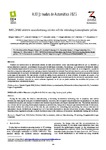Mostrar o rexistro simple do ítem
MOLDAM additive manufacturing robotic cell for extruding thermoplastic pellets
| dc.contributor.author | Bengoa, Pablo | |
| dc.contributor.author | Antolín-Urbaneja, Juan Carlos | |
| dc.contributor.author | González Ojeda, Itzel de Jesus | |
| dc.contributor.author | Ortega Lalmolda, Juan Antonio | |
| dc.contributor.author | Martínez Díez, Unai | |
| dc.contributor.author | Gkournelos, Christos | |
| dc.date.accessioned | 2023-10-11T17:18:32Z | |
| dc.date.available | 2023-10-11T17:18:32Z | |
| dc.date.issued | 2023 | |
| dc.identifier.citation | Bengoa Ganado, P., Antolín-Urbaneja, J.C., Gonzalez Ojeda, I., Ortega Lalmolda, J.A., Martínez, U., Gkournelos, C.. 2023. MOLDAM Additive Manufacturing Robotic Cell for extruding thermoplastic pellets. XLIV Jornadas de Automática, 528-532. https://doi.org/10.17979/spudc.9788497498609.528 | es_ES |
| dc.identifier.isbn | 978-84-9749-860-9 | |
| dc.identifier.uri | http://hdl.handle.net/2183/33752 | |
| dc.description.abstract | [Resumen] Durante los últimos años la fabricación aditiva se está posicionando como una tecnología atractiva por su sencillez y accesibilidad en el mercado, posibilitando la extrusión de diferentes materiales. Sin embargo, las dimensiones del área de trabajo y las limitadas capacidades de extrusoras comerciales de pequeñas dimensiones están derivando en la investigación y puesta en marcha de máquinas más grandes con una mayor tasa de deposición de material. Este artículo describe una nueva celda robótica automatizada para la extrusión de materiales termoplásticos en formato de granza o pellet siendo posible la extrusión de material a alta tasas de deposición. En este sentido, el artículo define la arquitectura de la celda robótica, el interfaz de usuario y los resultados preliminares. Además, se ha desarrollado el gemelo digital para la monitorización del proceso de una manera virtual. Finalmente, el artículo describe un nuevo software registrado en el que se puede analizar las variables del proceso o el comportamiento del material impreso. | es_ES |
| dc.description.abstract | [Abstract] During the last years, the additive manufacturing is becoming an attractive technology due to simplicity and market accessibility enabling the extrusion of different materials. However, the workspace requirements and the limitation of the small commercial extruders, are leading to research and develop big machines with higher material feed rate. This article describes a new robotic cell for extruding thermoplastic material in pellet format, being able to deposit high material feed rate. In this sense, this article defines the architecture of the cell, the user interfaces for controlling and monitoring the robotic cells and the preliminary results. Furthermore, a digital twin (DT) has been developed to monitor the process virtually. Finally, the paper describes a new registered software in which the data process or the behaviour of the printed material after testing can be shown. | es_ES |
| dc.language.iso | eng | es_ES |
| dc.publisher | Universidade da Coruña. Servizo de Publicacións | es_ES |
| dc.relation.uri | https://doi.org/10.17979/spudc.9788497498609.528 | es_ES |
| dc.rights | Attribution-NonCommercial-ShareAlike 4.0 lnternational (CC BY-NC-SA 4.0) https://creativecommons.org/licenses/by-ncsa/4.0/ | es_ES |
| dc.rights.uri | http://creativecommons.org/licenses/by-nc-sa/3.0/es/ | * |
| dc.subject | Gemelo digital | es_ES |
| dc.subject | HMI | es_ES |
| dc.subject | Robot | es_ES |
| dc.subject | Celda robótica | es_ES |
| dc.subject | Automatización | es_ES |
| dc.subject | Fabricación aditiva | es_ES |
| dc.subject | Impresión 3D | es_ES |
| dc.subject | Controlador lógico programable | es_ES |
| dc.subject | Digital twin | es_ES |
| dc.subject | Robotics cell | es_ES |
| dc.subject | AutomationAdditive manufacturin | es_ES |
| dc.subject | 3D printing | es_ES |
| dc.subject | Programmable logic controller | es_ES |
| dc.title | MOLDAM additive manufacturing robotic cell for extruding thermoplastic pellets | es_ES |
| dc.type | info:eu-repo/semantics/conferenceObject | es_ES |
| dc.rights.access | info:eu-repo/semantics/openAccess | es_ES |
| UDC.startPage | 528 | es_ES |
| UDC.endPage | 532 | es_ES |
| dc.identifier.doi | https://doi.org/10.17979/spudc.9788497498609.528 | |
| UDC.conferenceTitle | XLIV Jornadas de Automática | es_ES |






